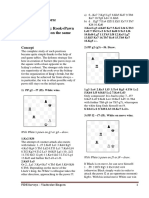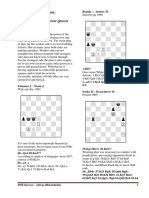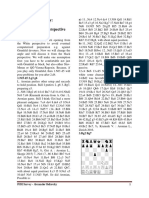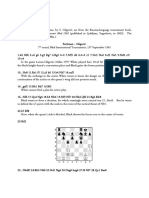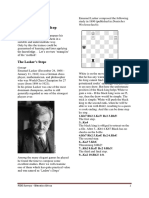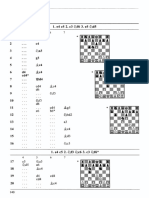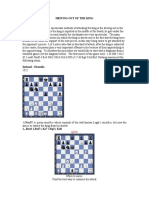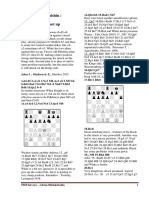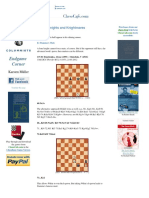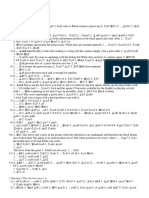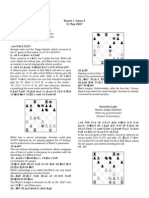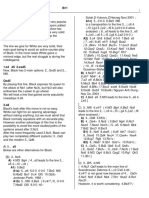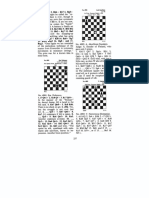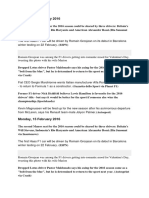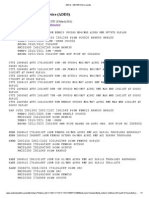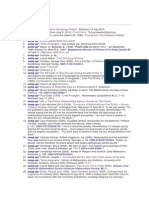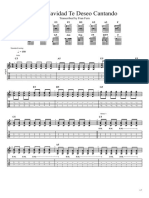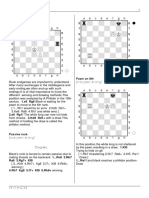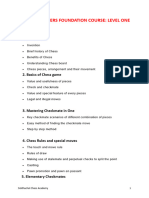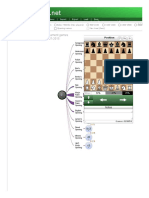5. Re3.
W commences a metamor- 4 As a consequence of a positional
phosis of the blockade of bS, for draw due to pinning, binding, per-
otherwise there is no win. 5. Rh2? petual attack, perpetual check, per-
Ke5. 5. ..., Bh7. 5. ..., Sd2 6. Kcl. petual threat of mate or of stale-
Or 5. ..., Ke5 (f5) 6. Sf2 Sd2 7. Kcl. mate, and so on, with, as a normal
6. Kcl. 6. Re2? may be craving case, the maintenance of all the
attention, but it does not win: 6. ..., material, or, an abnormal one, a
Kg5 7. Rf2 (Se3, Kf4; Sc2, Bd3; Rg2 sacrifice of a minor piece.
Be4; Rh2, Kg3, Rd2, Bf3; draws, and
it is the same after Rh2, Be4, Se3, From the viewpoint of studies cases 3
Kf4;) 7. ..., Kg4 8. Se3 + Kg3 8. Rf7 and 4 are of the greatest interest. But
Be4 10. Rd7 Kf4 11. Sc2, and how Bl in this article we wish to examine
manages to draw will be shown in only the sub-category of 4 where
K8. After 6. Kcl W has achieved the material balance is preserved: the
"type-l-into-type-2" change, and the other sub-category involving a sacri-
decisive manoeuvre follows. 6. ..., fice deserves an article to itself.
Bg6. Bl really has no useful move. 7. The drawing possibility by means of
Rb3. This is the necessary position of alternating checking with defence of
wR for winning a "type 2" blockade an attacked piece was seen in a rudi-
set-up. 7. ..., Ke5 8. Se3 Kd4 9. mentary form in Kl in the try (3.
Sc2+. All with gain of tempo. 9. ..., Kf2? Sd2 4. Rh5 Bg5 5. Ke2 Se4 6.
Bxc2. The only alternative: 9. ..., Kc4 Kf3 Sd2+ 7. Ke2 Se4, a positional
10. Rxbl Kc3 11. Rb2 (b8). 10. Kxc2, draw), but it occurs in K6 in a
and bS finally succumbs to the developed form. The initial position:
blockade. All that remains to add is
K6 A.G. Kopnin
that after 4. ..., Be2 W easily wins by 2 Hon. Men., Korolkov Jubilee
changing the blockade: 5. Kcl Bg4 6. Tourney, 1977
(position after W's move 10)
Rb3 Bf5 7. Se3 B- 8. Sc2.
The examples we have seen exhibit
the methods of taking advantage of
positional features (both general and
special) for winning purposes in the
GBR class 0134 endings.
Examination of the methods of
exploiting positional features (both
general and special) for drawing
purposes also has its interest. (Natu-
rally, the GBR code for these endings Black to Move. Draw 3 +3
may change, for instance 0134 beco-
mes 0314, but the relationship of the wKe2 wBal, e8 wSc8 wPf6 - bKc6
forces is constant.) bRg3 bBd7 bSg8, h7: draw. K6 is the
A draw in the ending 0314 (as in the position after 1. f7 Sh6 2. Be5 Rg4 3.
endings 0305, 0332, 0341, 0323, 0350) Se7+ Kc5 4. Bxd7 Re4+ 5. Kf2
is the inevitable result in any of these Rxe5 6. Sg6 Rg5 (Re4; f8Q + , Sxf8;
circumstances: Kf3, Rel; Kf2, Re4; Kf3, with a
1 After the exchanging of a minor positional draw) 7. f8Q+ Sxf8 8.
piece and the appearance of a Sxf8 Rg8 9. Se6+ Kd6 10. Ba4. Play
drawn position of the type S vs. R now proceeds with Bl to move. 10.
or B vs. R. ..., Ra8. 10. ..., Rg4 11. Bdl, but not
2 After the exchange of both minor 11. Bb3? Rb4 11. Ba2 Rb2 + . 11.
pieces for the R. Bb3 Rb8. 11. ..., Ra3 12. Sd4 draws.
3 Stalemate. 12. Sd4 Kc5 13. Sd6+. 13. Ke3?
227
�Sg4+ Sg4+ 14. Kd3 (e4) Rd8 (b4). 15. Ra3 Bc5 16. Rg3 Bd4, and it is a
13. ..., Kd6 14. Sd4 Kc5 (Ke5; Sc6 + ) positional draw.
15. Se6 + Kd6 16. Sd4 Rb4. Bl's last Thus in K7 there is a straightforward
fling. 17. Ke3. Now this move is not case of the specific motif (blockade
only possible, but necessary. 17. ..., of bS as motif for a W win) and its
Kc5. Again if 17. ..., Ke5 18. Sc6+. antiform (blockade of wS as a motif
18. Se6+ Kd6 19. Sd4, a positional for Bl obtaining a draw).
draw. Bl achieves nothing by trying
19. ..., Sg4+ 20. Kd3. On the other K8 A.G. Kopnin
hand W would lose by playing 19. "64-Shakhmatnoe Obozrenie",
i.80
Ba2? Sg4+ 20. Kd3 Rb2 21. Bc4
Se5 + 22. Kc3 Sxc4 23. Sf4 Rh2.
Now, what drawing possibilities does
the weaker side have, with respect to
specific positional features, namely
where the "defending" S is blocka-
ded?
Position after W's
move 5, in K4
K8 shows a different aspect of the
positional draw. Bl threatens to win
the blockaded wS, so W has to
guarantee its safety. 1. Bb3? is a try
that loses like this: 1. ..., Kg7 2> Kd4
(or Kb4, Sf7; Bxf7, Kxf7; Sh6 + ,
Kg6; or Kd3 (c3), Re8; and Se6;) 2.
..., Sf3+ 3. Kd3 (best) 3. ..., Rel
Black to Move. Draw 3+ 3 and W is in zugzwang: 4. Ba2 Sg5
Let us revert to K7, which can arise (see K3), or 4. Kc3 Re3 + 5. K- Sg5.
from K4 after 5. Se8. There is only one road to draw.
5. ..., Kc2. Now it emerges that it is 1. Kd4 Re4+. Bl wins a tempo with
not only bS that is blockaded, but wS this move in order to attack wS. Bad
also. 6. Sd6 (c7) Be5 7. Rg2 + Kd3 8. is 1. ..., Re8 2. Bh5 + . 2. Kc5. Every
Sf7 Bd4 9. Rg3+ (Sg5, Be3; Rg3, other move loses. 2. ..., Re3. Bl is in
Se2; is a draw) 9 Ke4 10. Rg4 + no hurry to play ..., Kg7; for he has
(or Sg5 + , Kf4;) 10. ..., Kd3 11. the possibility simply not to permit
Rg3 + Ke4, with a positional draw. wB to play to the square b3, so every
After 5...., Kc2 we have a position of Bl move tests W's alertness! 3. Kd4
reciprocal zugzwang. 6. Ra3 Bc5 Re4 +. W does not fall for the coarse
7. Ra5 Bd4 8. Ra3 Be5 9. Rg3 Bd4 trap (3. Kd6? Rd3 + ) so Bl once
10. Kel. W counts on a triangulation more wins a tempo with a check. 4.
to give Bl the move. 10. ..., Bc3 + Kc5 Kg7 5. Bb3 Sf7. Bl at once sets
11. Kf2 Be5. W counted on 11. ..., about taking advantage of the poor
Bd4 + ? 12. Kfl and Bl is in position of wK. 6. Bd5. Pointless is 6.
zugzwang: 12. ..., Kd2 (Kdl; Rd3 + , Bxf7? Kxf7 7. Sh6+ Ke6 (g6), or 7.
or Bc5; Sf6 for Se4 and Sf2) 13. Sd6 Kd5 Rh5. 6. ..., Re2. 6. ..., R- 7.
Be5 14. Sc4+. 12. Ra3. 12. Rg4 Bxf7 draws, or 6. ..., Re5 7. Kd4 and
Sh3 + 13. Kf3 Sf4 14. Ke4 Sd3. 12. 8. Bxf7. 7. Bc4 Re4. bR returns to
..., Bd4 + 13. Kfl Bc5 14. Ra5 Bd4 this strong square because if 7. ...,
228
�Re8 (el) there follows 8. Bxf7. 8. Bd5 playing 4. ..., Kc2. wS is now
Re2. blockaded and Bl threatens 6. ...,
9. Bc4, with a positional draw by Ral and 7. ..., Rxbl. 6. Ke6 Ral 7.
perpetual attack by wB on bR, taking Kd5 Ra5+. It is clear that on 7. ...,
away its best squares of retreat. We Rxbl there follows 8. Kd4 Rb3 9.
may observe that after 9. ..., Re3?! Ke3 and we have a known positional
W cannot immediately bring about draw where bS is pinned solid and W
the exchange of minor pieces (10. has enough squares from h7 to e4.
Bxf7? Kxf7 11. Sh6+ Ke6 12. Sg4 This positional draw is one of the
Rf3, and after the best reply, 13. Kc6 special sacrificial cases under 4.
we have Reti's position with colours 8. Ke6 Re5+ 9. Kf6 Ra5 10. Ke6
reversed, in which Bl wins by Ra6+ 11. Kd5 Ra5+ 12. Ke6 Ral
transferring the zugzwang to W: 13. 13. Kd5, and that is the first
..., Kf5 14. Sh6+ Kf6 15. Sg4+ Ke6). positional draw.
This is why, after 9. ..., Re3?! W 4...., Kb2 5. Bf5. Not 5. Sd2? Sxg4 + .
must first play 10. Kd4 Re- and only 5. ..., Rd5. wS is held by a "type 1"
now 11. Bxf7 Kxf7 14. Sh6 + , blockade. 6. Ke6. Unique move to
transposing into a drawn S vs. R draw. 6. Kg5? Rd4 and Bl will win,
endgame. see K5. 6. Bg6? Rd6+ 7. Kf7 (or
Our final example shows the drawing Kg5, Sh3 + ; and Sf4;) 7. ..., Sd3
possibilities of the weaker side in (simplest) 8. Sd2 Sf4. 6. Bh7? Sg4 +
specific positions (ie blockade of S) in 7. Ke6 Rh5 8. Bg6 (Bf5, Se3; B-,
2 variations ending in positional Rh2; or Be4, Rh5 + ; or Bd3, Se3;
draw. Sd2, Rh6; Ke5, Kc3;) 8. ..., Rh2 9.
K9 A.G. Kopnin Kf5 Se3 + 10. Kf4 Sc2 11. Kg3 Rh6,
1st Prize, Podolsk see K5. 6. ..., Rd8. If 6. ..., Rdl (d4)
Bicentenary Tourney, 1981
(position after W's move 2) 7. Ke5. 7. Kf6. Once again the only
move. 7. Ke5? Sd3 +. 7. Ke7? Rd4 8.
Kf6 (Ke6, Sd3; Sd2, Sc5 + ;) 8. ...,
Sg4 + , as in K5. 7. Bg6? Sd3 8. Ke7
Rd4 9. Sd2 Sf4. 7. Bh7? Sd3 8. Ke7
Rd4 9. Sd2 Sc5 10. Sf3 Rd7 + and
11. ..., Rxh7. 7. ..., Rd5. The answer
to 7. ..., Rdl is the same as to 7. ...,
Sdl, namely 8. Ke5. 8. Ke6 Rd8 9.
Kf6, with a positional draw by virtue
of alternating attack by wK on bR
Black to Move. Draw and departure of same for the
"outpost of empire" f6!
K9 is from the following set-up:
wKf5 wBg4 wSe5 - bKb2 bRa6 bSh3 Tourney
bPd2: draw. After 1. Sc4+ Kc3 2. "Walter Korn Jubilee", to celebrate
Sxd2 we have the diagram. 2. ..., the 75th birthday of the Czech-born
Ra5 + . Bl has nothing from 2. ..., American player-author-composer.
Sf2 3. Se4+. 3. Kf6. 3. Ke6 (g6)? bntries invited from: USA, Canada,
Sf4+ 4. K- Kxd2. Or 3. Ke4 Sf2+ 4. Central America, South America on-
Kf3 Sxg4 5. Se4 + Kd4. 3. ..., Sf2. W ly. Send to: George Koltanowski,
has 2 pieces en prise, so his next 'Hnd Game Competition', 1200
move is the only one. 4. Sbl + . Now Gough Street, Apt. 3-D, San Francis-
Bl has 2 possible moves: 4. ..., Kc2 co, California 94109, U.S.A.
and 4. ..., Kb2. 4. ..., Kc2 5. Bf5 + Judges: Walter Korn + another. Clo-
Sd3. Bl relied on this move when sing date: 31.xii.83.
229
� XXVI CONGRESS OE THE in games of the leading players.
PERMANENT COMMISSION OE There are no studies in these books,
E.l.D.E. FOR CHESS but some fine endings, and many a
COMPOSITIONS ~ 29.viii.83 composer would be delighted to have
to 5.ix.83. discovered Pfleger's winning move
The venue was Bat Yam, a few miles against Larsen -61. Sg2.
south of Tel Aviv on the coast of the H. Pfleger vs. B. Larsen
Mediterranean. AJR attended, lor Manila, 1974
Position after Bl's 60th move
the first time since Canterbury (1978),
but Barry Barnes, Vice-President,
was delegate tor Great Britain. Ro-
land Baier of Switzerland won the in-
dividual solving title (World Cham-
pion), and Finland, led by Pauli Per-
konoja, won the learn title. Jan Ru-
sinek (Poland) was awarded the title
of Judge (studies). On the private and
personal side 1 met many old friends
and made many new ones (with com-
White to Play
puter associations, especially: Uler
Comay* and Mika Korhonen). The
meeting was a considerable success, "The Art of Israeli Chess Composi-
with great hospitality and great weat- tion", edited by Yoel Aloni and Uri
her, but more countries may be ex- Avner, 1983, 152 pages, 635 dia-
pected to attend in Sarajevo in Yugo- grams, photographs. There are 8 sec-
slavia in August 1984. In Bat Yam tions to this fine book, which appea-
countries represented by deligates red dramatically on time at the XXVI
were: Austria, Great Britain, Finland, FIDh, Commission meeting, and the
France, West Germany, Israel, studies section contains 130 composi-
Netherlands, Romania, Spain, Swe- tions, second in quantity only to the
den, Switzerland, USA, Yugoslavia - 2-ers. In inventiveness and in ac-
and Belgium (new). curracy the studies impress greatly.
The book may obtained by sending
* Ofer Comay will figure in EG 75 in $ 16.00 to Un Avner, 16 Hazamir
a sequal to the 0023 story. Street, Ramat-Gan, 52-596 Israel. Uri
was also the organiser of the Con-
gress, and rightly received an ovation
from all attendees. Since he had also
REVIEWS spent some time in hospital, even du-
"Dr. Robert Hubner - 60 seiner ring the Congress, his achievement
schonsten Partien", by Manfred von and courage are beyond praise. (Ihe
Fondern and Peter Kleine, 2nd ed., $ 16.00 includes postage. The book is
1982, West Germany (Beyer Verlag). not available from AJR).
"Die besten Partien deutscher
Schach-Grossmeister", edited by Hel-
mut Pfleger, 1983, West Germany DIAGRAMS AND SOLUTIONS
(Falken Verlag).
No. 4973: N. Kralin.
It is salutary for studies enthusiasts to 1. h4 (Kxh2? Ke2;) 1. ..., d3 2. h5 gh
be reminded of the connection with 3. g5/i Kg3 4. g6 Kh3 5. g7 h4 6.
the game, and that ideas which we g8S/ii Kg3 7. Sf6 Kf3 8. Kxh2 Ke2 9.
applaud in studies occur quite often Se4 wins.
230
� No. 4973 N.Kralin
Hon.Men., Shakhmaty v SSSR, 1981
to trap wS, but... 11. Sf8 Rd6 12.
Sh7, and wS eludes encirclement.
"A study with a new and effective
sacrifice of wQ. Unfortunately the
sharpness of the struggle thereafter
drops off..."
No. 4975 V.I. I
(vi.81)
Hon.Men., Shakhmaty v SSSR, 1981
Win 4+4
i) The thematic try here is 3. gh? Ke2
4. h6 Kxd2 5. h7 Kel 6. h8Q d2, with
a known Troitzky draw. But in our
Bl tries another approach to stalema-
te.
ii) 6. g8Q? is stalemate. 6. g8B? Kg3
7. Bh7 Kf2 8. Bxd3 Kel and 9. ..., Win
Kxd2.
No. 4974 G. Slepyan
No. 4975: V.I. Kalandadze.
(i-81) 1. Rb7 + Kc8. Or 1. ..., Ka8 2.
Hon.Men., Shakhmaty v SSSR, 1981 Ra7 + Kb7 3. c7 +. 2. Kgl. The start
of a "yomp" along the first rank. 2.
..., Rc2 3. Rc7+ Kb8 3. ..., Kd8 4.
Rd7 + Kc8 5. b7 + . 4. Kfl Rb2 5.
Rb7 +. wR gives remote support by
harassing the enemy HQ. 5. ..., Kc8
6. Kel Rc2 7. Rc7+ Kb8 8. Kdl Rb2
9. Rb7 + Kc8 10. Kel Rb5. The most
obstinate. The yomping continues up
and over. 11. Kd2 Rc5 12. Rc7 + Kb8
13. Kd3. From this point on there is
more than one winning move (13.
Ke3 also), but they all lead to Port
No. 4974: G. Slepyan. Stanley! 13. ..., Rb5 14. Rb7+ Kc8
1. b8Q Rh4+ 2. e4 Rxe4+. This 15. Kd4 Rbl 16. Kd5 Rdl+ 17. Ke6
removes W's defence of the b3 Rel + 18. Kf7 Rcl 19. Rc7+ Kb8 20.
square. 3. Sxe4 Bc2+. What now? 4. Ke8 Rbl 21. Kd8. Casualties cannot
Kb4? Rb3 + 5. Kc4 d5 + 6. Kd4 be avoided. This one is instantly
Rxb8 7. Sc5+ Kb5 8. Kxd5 Rc8 9. decisive. 21. ..., Rxb6 22. Rc8 +
Se6 Bb3 + . So... 4. Qb3 Bxb3 + 5. wins. The topical "Falklands Is-
Ka3 Re3 6. cd. And not 6. Sc5 + ? lands" notes are, of course, AJR's.
Kb6 7. cd Bd5+ and 8. ..., Kc7. 6. Our apologies to non-British readers.
..., Ba4+ 7. Kb2. If 7. Kxa4? Rxe4 + "Yomp" is not in the dictionary...
and 8. ..., Rd4. 7. ..., Rxe2+ 7. ..., "An attractive 6-man R-ending mi-
Rb3 + 8. Ka2 Rb8 9. Sc5 + Ka5 10. niature, organically marred by duals
Sb7+ and 11. d8Q. 8. Kc3 Bxd7 9. in the march of wK. I think that this
Sc5 +. A fork, in spite of everything. discovery will find a place in the
9. ..., Kb5 10. Sxd7 Re6. An attempt books."
231




